MICROSCOPE-ANTIQUES.COM © 2013-15.
McARTHUR PORTABLE COMPOUND MICROSCOPE
C. 1989
SIGNED: 'McARTHUR MICROSCOPES LTD'
SIGNED ON CASE: 'KIRK TECHNOLOGY'
SERIAL NUMBER: 2052
MODEL: KIRK-MCARTHUR PORTABLE MICROSCOPE
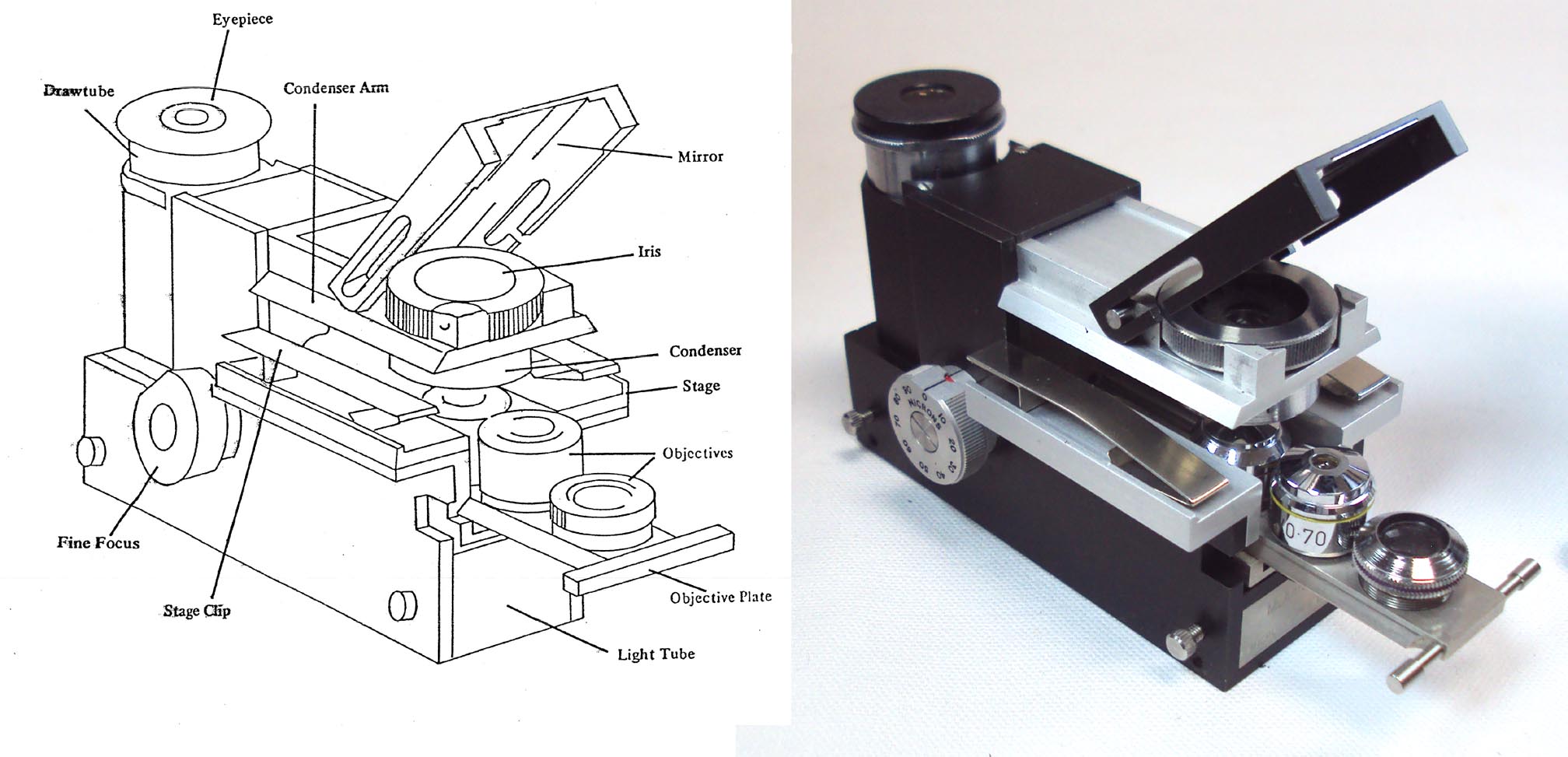
DESCRIPTION:
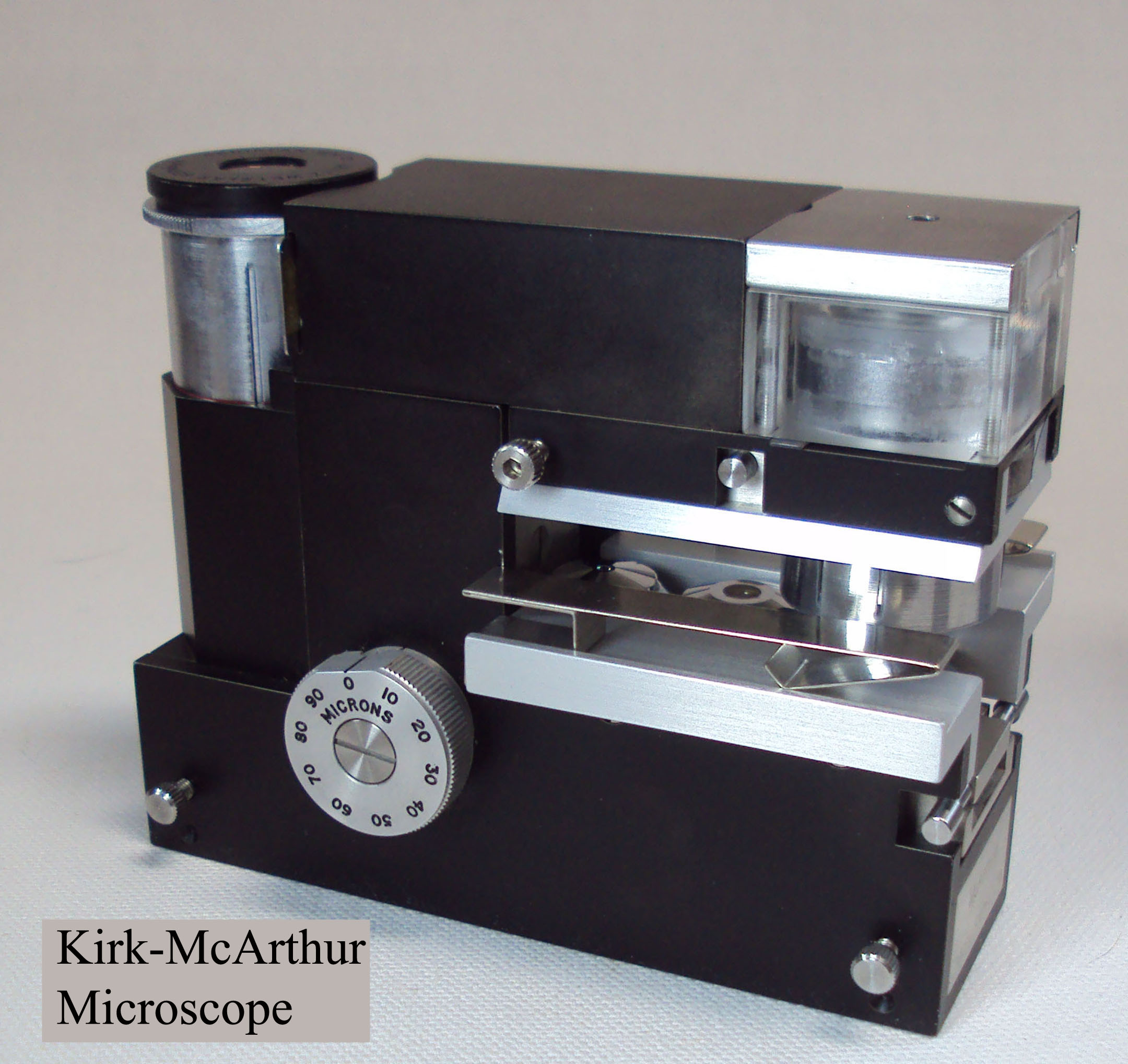 This instrument, without the angle tube or Traversing Stage, measures 4 x 3 1/4 x 2 inches
in widest dimensions. The Traversing (glide) Stage is designed to accept standard size slides and so measures 4 inches
wide. The main body is made of an aluminum alloy, so that, although solid and firm, it weighs about 16 ounces; compare
this to the weight of the original McArthur-Watson which weighed 3 pounds, 12 ounces.
The classic configuration, as shown above, and described below, would be with stage clips and the stainless steel mirror. The following description is mainly
taken directly from the paperwork supplied with the microscope. The image to the left shows the microscope equipped with the electric illuminator
This instrument, without the angle tube or Traversing Stage, measures 4 x 3 1/4 x 2 inches
in widest dimensions. The Traversing (glide) Stage is designed to accept standard size slides and so measures 4 inches
wide. The main body is made of an aluminum alloy, so that, although solid and firm, it weighs about 16 ounces; compare
this to the weight of the original McArthur-Watson which weighed 3 pounds, 12 ounces.
The classic configuration, as shown above, and described below, would be with stage clips and the stainless steel mirror. The following description is mainly
taken directly from the paperwork supplied with the microscope. The image to the left shows the microscope equipped with the electric illuminator
'The mirror is opened for use by sliding
it forward along the condenser arm to its full extent. It can then be raised to a convenient angle to reflect light
into the microscope from a suitable external source. When not in use, the mirror forms a dust cover for the iris
and condenser. The mirror can be removed and replaced by an electric lamp or other accessory. To remove, slide the
mirror forward half-way and lift off.'
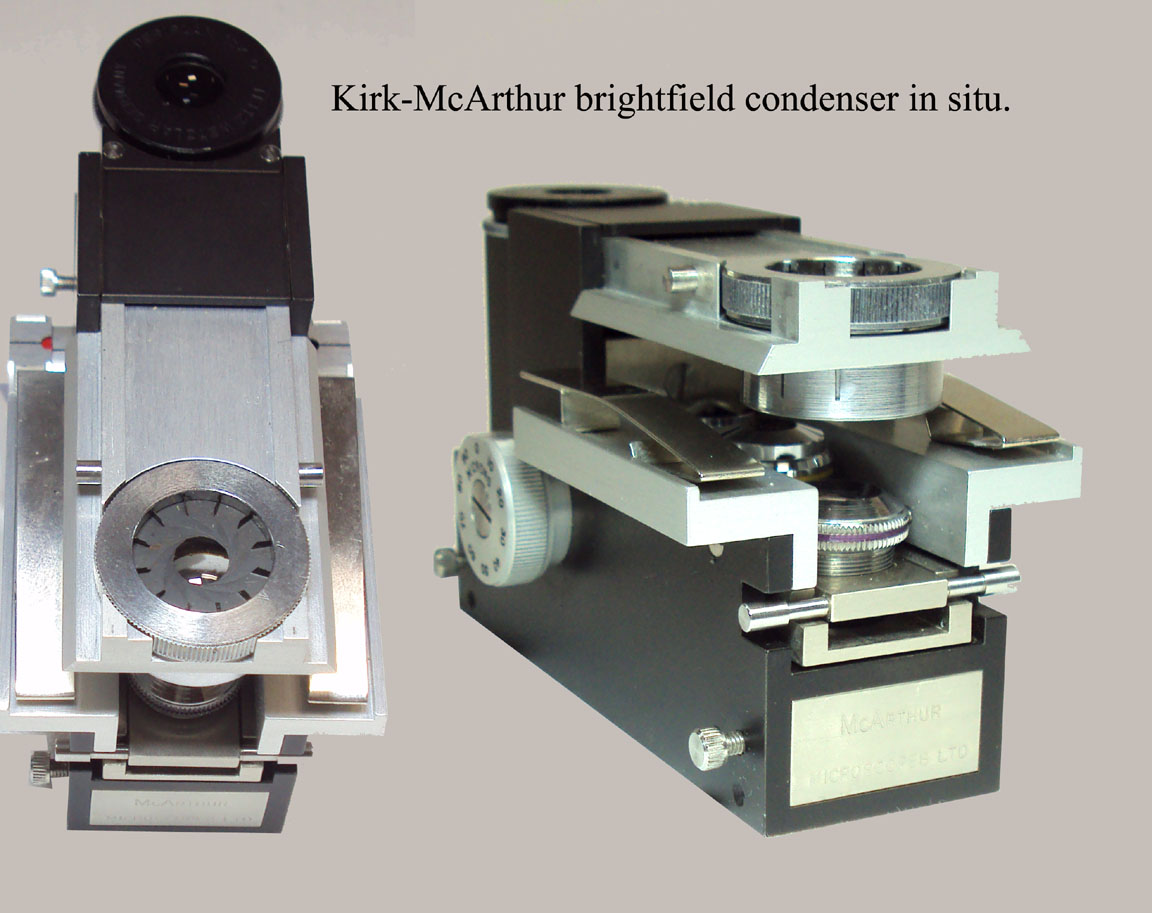 The Condenser, shown on the left installed but with the mirror removed for clarity, 'is held rigidly in correct focus and requires no adjustment. It can be lifted out for cleaning or for
replacement with other condensers for special applications. The iris is operated by rotating the knurled ring'.
The Condenser, shown on the left installed but with the mirror removed for clarity, 'is held rigidly in correct focus and requires no adjustment. It can be lifted out for cleaning or for
replacement with other condensers for special applications. The iris is operated by rotating the knurled ring'.
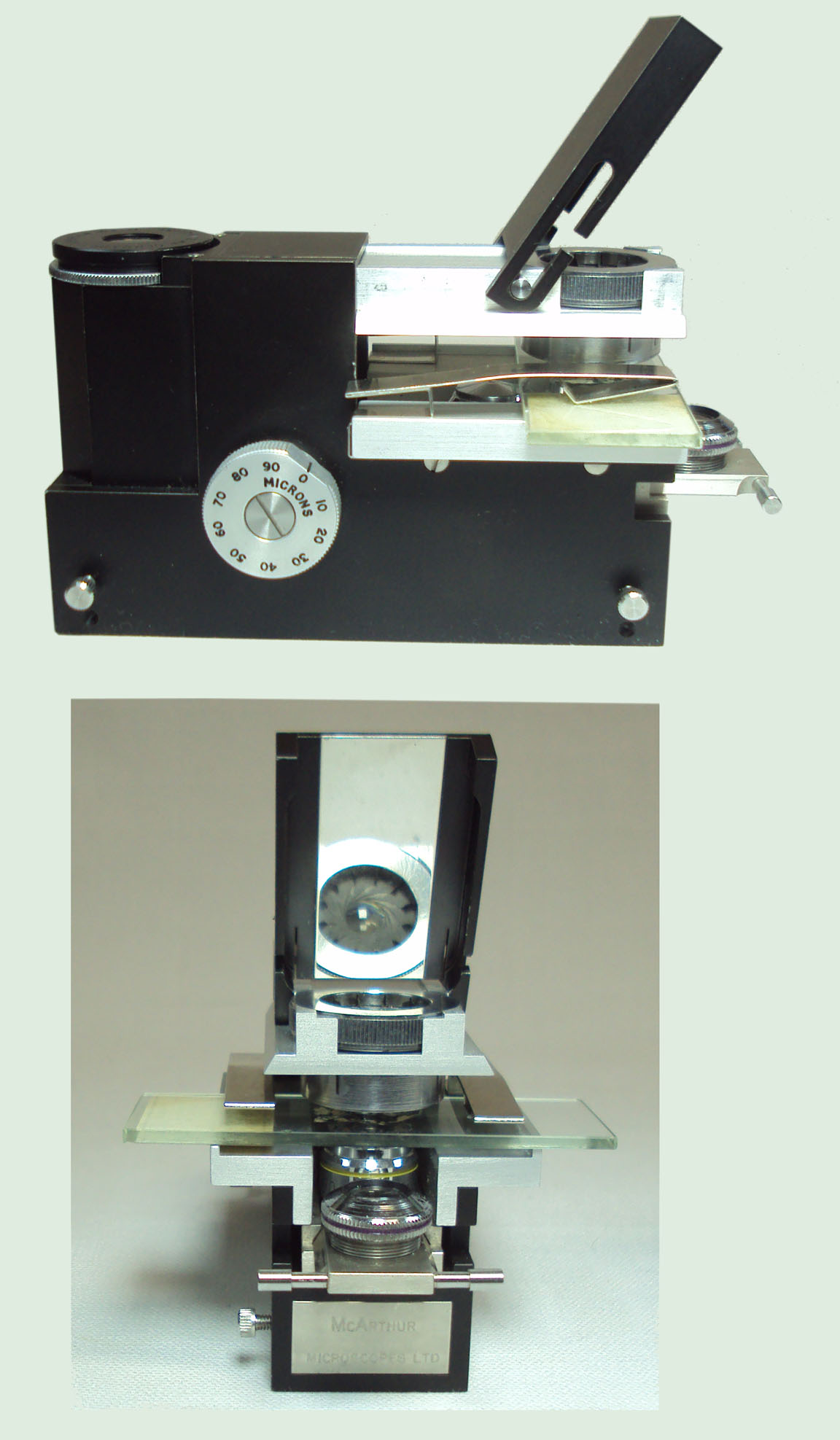 As shown on the right, 'the stage holds normal glass slides, held in place by two spring clips, one on each side. Slides must be
inserted with the specimen BELOW the slide... The spring clips can be slid off when not required and clipped beneath.
'
As shown on the right, 'the stage holds normal glass slides, held in place by two spring clips, one on each side. Slides must be
inserted with the specimen BELOW the slide... The spring clips can be slid off when not required and clipped beneath.
'
'The objectives are (semi) permanently mounted on a sliding objective plate below the stage.
In the fully closed position, the 10X lens is in place. Sliding the plate out locates the 40X and 100X objectives in turn.
The plate can be removed for cleaning the lenses, or for replacement with a different set of objectives by sliding
it fully out. The objectives are parfocal with each other, so that a specimen focused by one will be in focus with the
others. The 10X lens can be rotated in its mount to adjust for any change in tube length. Alteration of the tube length
has little effect on the focus of the high power objectives. If however, the drawtube of the eyepiece is extended, the
10X objective must be rotated upwards to compensate.' A knurled top and a knurled locking ring, allow the change to be
made secure once made.
This instrument is complete with many accessories including:
- two stage clips
-
a dissecting stage
- an electric illuminator, with retractable diffuser screeen, powered by two AA batteries
- an angled tube fitting allowing comfortable viewing at an angle without tilting the microscope
- a standard mirror fitting with stainless steel mirror
- a Traversing (glide) Stage
- a (added later) lying drop slide signed Burwell Engineering
- a water-immersion dark ground condenser signed 'DG'
- a phase contrast condenser signed 'PH'
- bright field condenser with adjustable iris diaphragm
- a objective plate containing a 10X brightfield unsigned but labelled '10X', a
40X phase contrast objective signed 'McArthur 40X/0.70', and a 100X oil-immersion phase contrast objective signed 'McArthur 100 X/1.030 OIL'
- a second objective plate containing a 5X labelled '5X' but unsigned, 40X signed '40X/0.70 Prior', and an unsigned and unlabelled 100X brightfield
- two spare electric bulbs
- an eyepiece micrometer disk
- a single Watson and Son 10X eyepiece
- seven pages of printed notes and instructions, with two figures, housed in a plastic sleeve
- an integral draw tube about one inch long, with a circumferential scribed line about its middle
- a purpose-made blue plastic case with custom foam cutouts to accomodate most of the above
One objective plate holds the 5X, 40X, and 100X brightfield objectives, while the other holds a 10X brightfield,
and 40X phase contrast and a 100X phase contrast objective. I have recently been able to add lying drop slides
obtained in 2013 from Burwell engineering in Cambridge, UK.
The dissecting stage
, the only plastic part,
is unique in that it sits on top of the condenser arm (condenser removed) and is used with stage clips and the slide
upright. The stage has slots fitting over the pins that hold the illuminators or mirror in place, which prevents if from moving
forward or backward, and has a thumbscrew for further stability if desired. This stage is designed to be used with the
5X objective. Focusing when using this stage is achieved by pulling out both the draw tube and eyepiece to appropriate
positions. Unfortunately, the angle tube cannot be used in this configuration, the user then not being able to reach focus.
I have discovered that the fittings on the end of the stage clips which make contact with the slide are tender and
break if bent; to increase the tension of the stage clips, the clips should be bent further in their middle rather than
the end!
HISTORY: This is the Kirk version of the famous McArthur microscope, called the Kirk-McArthur model.
It incorporates almost all of the improvements made in the design. This instrument also came in a metallurgical model, a surface inspection model, and an
interferometer version. The circulars from the company can be seen in the original paperwork from 1988. The 'engineering' model combines the accessories for the metallurgical model and the surface inspection model, examples of these now on the website. Another model was designed as an interferometer, also on this site. The quality and precision of these instruments is really quite impressive. For much more on the history of the McArthur microscope, please see my McArthur Main page.
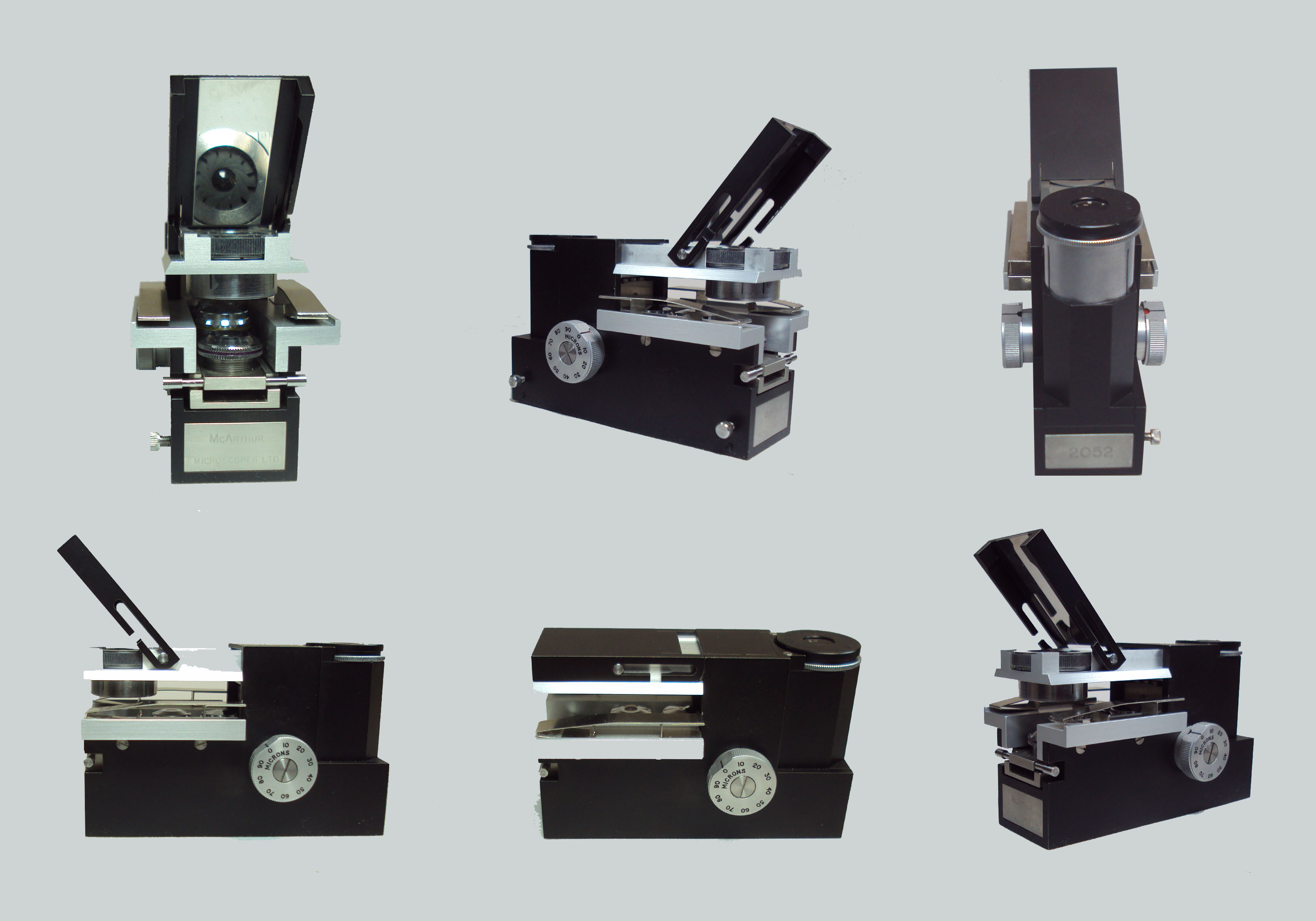

 This instrument, without the angle tube or Traversing Stage, measures 4 x 3 1/4 x 2 inches
in widest dimensions. The Traversing (glide) Stage is designed to accept standard size slides and so measures 4 inches
wide. The main body is made of an aluminum alloy, so that, although solid and firm, it weighs about 16 ounces; compare
this to the weight of the original McArthur-Watson which weighed 3 pounds, 12 ounces.
The classic configuration, as shown above, and described below, would be with stage clips and the stainless steel mirror. The following description is mainly
taken directly from the paperwork supplied with the microscope. The image to the left shows the microscope equipped with the electric illuminator
This instrument, without the angle tube or Traversing Stage, measures 4 x 3 1/4 x 2 inches
in widest dimensions. The Traversing (glide) Stage is designed to accept standard size slides and so measures 4 inches
wide. The main body is made of an aluminum alloy, so that, although solid and firm, it weighs about 16 ounces; compare
this to the weight of the original McArthur-Watson which weighed 3 pounds, 12 ounces.
The classic configuration, as shown above, and described below, would be with stage clips and the stainless steel mirror. The following description is mainly
taken directly from the paperwork supplied with the microscope. The image to the left shows the microscope equipped with the electric illuminator The Condenser, shown on the left installed but with the mirror removed for clarity, 'is held rigidly in correct focus and requires no adjustment. It can be lifted out for cleaning or for
replacement with other condensers for special applications. The iris is operated by rotating the knurled ring'.
The Condenser, shown on the left installed but with the mirror removed for clarity, 'is held rigidly in correct focus and requires no adjustment. It can be lifted out for cleaning or for
replacement with other condensers for special applications. The iris is operated by rotating the knurled ring'.
 As shown on the right, 'the stage holds normal glass slides, held in place by two spring clips, one on each side. Slides must be
inserted with the specimen BELOW the slide... The spring clips can be slid off when not required and clipped beneath.
'
As shown on the right, 'the stage holds normal glass slides, held in place by two spring clips, one on each side. Slides must be
inserted with the specimen BELOW the slide... The spring clips can be slid off when not required and clipped beneath.
'